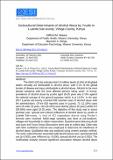| dc.contributor.author | Clifford M. Matara, Maureen A. Winga | |
| dc.date.accessioned | 2022-01-31T08:32:05Z | |
| dc.date.available | 2022-01-31T08:32:05Z | |
| dc.date.issued | 2021 | |
| dc.identifier.issn | :1857-7431 | |
| dc.identifier.uri | https://repository.maseno.ac.ke/handle/123456789/4798 | |
| dc.description | DOI: https://doi.org/10.19044/esj.2021.v17n14p121 | en_US |
| dc.description.abstract | The World Health Organization (WHO, 2014) indicates that 3.3
million deaths or 5.9% of all global deaths annually are attributable to alcohol
abuse. The WHO (2014) further indicates that the global burden of disease and
injury attributable to alcohol abuse stands at 5.1%. Alcohol consumption
relates to more than 200 health conditions. New studies have given data on
causal relationships between alcohol abuse and the incidence and clinical
outcomes of infectious diseases including tuberculosis, HIV/AIDS and
pneumonia. Besides, alcohol is associated with social, economic, mental and
emotional issues expressed as absenteeism or abuses in social institutions such
as workplaces and relationships. Non-consumers of alcohol have often
become victims of alcohol related incidences.
Youths are defined by the United Nations as young people between the
ages of 15-24 years of age (United Nations, 2015). This is purely for statistical
purposes without prejudice to other definitions by Member States. The
Government of Kenya defines ‘youth’ as any person between the ages of 18-
35 in its Kenya National Youth Policy (Government of Kenya [GOK], 2006).
Seventy-five per cent of the Kenyan population are aged 30 years and below
(Kenya National Bureau of Statistics [KNBS], 2017). According to the
National Agency for the Campaign against Drug Abuse [NACADA] (2012),
Alcohol is the most abused substance in Kenya. Current abuse of alcohol in
Kenya among persons aged 18-35 years is 17.6% against the national average
of the general populace which is at 13.6%; with the urban youthful population
abusing alcohol more frequently (17.0%) compared to the rural youthful
population (11.8%). Moreover, more males abuse alcohol than females.
NACADA (2012) also indicates that the Western Region of Kenya aggregate
of sub-counties including Luanda reported current usage of 10.2% of alcohol
within the population. However, a study done in Kakemega County by
Takahashi, Wilunda, Karani, Wilunda and Useneya (2017) set the prevalence
of alcohol abuse at 31.7%. The report alludes to under reporting of prevalence
rates by a Kenyan government agency, NACADA, and proximity of the
Western region to the republic of Uganda, which has a prevalence of 28.6%.
It also infers to the shared ethnic and cultural backgrounds between Western
Kenya and Uganda including trends of alcohol abuse. | en_US |
| dc.publisher | ESJ Natural/Life/Medical Sciences | en_US |
| dc.subject | : Social, Cultural, Alcohol Abuse, Youth, Kenya | en_US |
| dc.title | Sociocultural Determinants of Alcohol Abuse by Youths in Luanda Sub-county, Vihiga County, Kenya | en_US |
| dc.type | Article | en_US |

